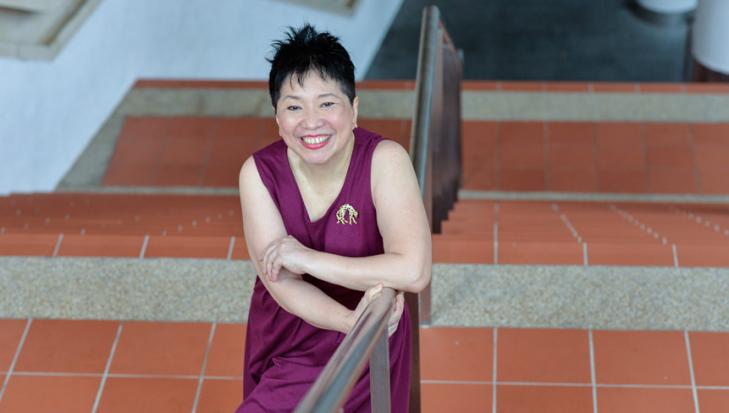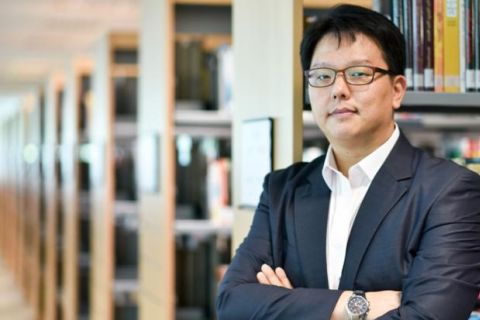
SMU Associate Professor Margaret Chan’s research on Chinese spirit-medium worship sheds light on political events playing out on the international stage.

Photo Credit: Cyril Ng
By Yamini Chinnuswamy
SMU Office of Research (15 Nov 2014) – What does it take to be an ethnographer, a scholar of people and cultures? According to Associate Professor Margaret Chan from the Singapore Management University (SMU) School of Social Sciences, one would need insatiable curiosity, sharp eyes, quick thinking and a strong pair of legs. A strong stomach might also help, she adds, because part of her research sees her travelling to China, Taiwan and Southeast Asia to study rituals of self-mortification.
Such rituals are part of the broader phenomenon of Chinese spirit-medium worship, a 5,000-year-old religious practice that is still actively upheld in Fujian province, as well as by the Hokkien diaspora across Taiwan and Southeast Asia.
“Spirit-medium worship is a Hokkien practice, and I am Hokkien. Watching spirit-mediums was a part of my life. Once I saw a spirit-medium cut a part off his tongue and hold it out on a skewer for all to see. I was at the most five years old then,” shares Professor Chan, who has been intrigued by spirit-medium worship from a young age. “I wanted to research this culture of my people that I knew nothing about. I wanted to understand my people.”
From Neolithic times to the modern day
For many, such rituals might be considered anachronistic in the modern day and age. Professor Chan disagrees, however, noting that they are part of the indigenous religion of China, which has existed, in the words of renowned anthropologist Professor J. J. M. de Groot, “since even before the dawn of time”.
Despite campaigns by Qing reformers in the late 19th century and the Chinese government to put an end to these superstitious practices, spirit-medium worship has endured, deepening Professor Chan’s fascination with the subject.
“Why are these rituals, which can be traced back to Neolithic times in the land we now know as China, still being performed today? That’s part of the question I want to answer,” Professor Chan says. “It’s curious, marvellous and exciting to find that a ritual element, say a particular zig-zag style of walking, can be traced to the mythical founder of the proto-Chinese Xia dynasty; to the legendary Zhongkui, the demon-queller of the Tang dynasty; to Hoi Fan, an indigenous god of the Yao people; to present-day spirit-mediums in China, Taiwan, Indonesia, Malaysia, Singapore and Thailand.”
But Professor Chan is quick to explain that she is not studying religion per se. “My discipline is performance studies, anthropology,” she notes. “I am not just recording a cultural practice for itself—rather, I ask, ‘Why are the people performing these rituals? What are they trying to say? What does their performance tell us about their society, the way their community thinks?”
Professor Chan highlights an example in the practice of Chinese spirit-mediums that sees them parading around the geographical boundaries of their precinct.
“The ritual intent is exorcism. They’re driving away demons of disease and misfortune, for example on the 15th day of Chinese New Year,” she explains.
“The fact that this ritual exorcist-led procession has a definite origin in the Zhou dynasty, and is still being practised today in a way that closely matches accounts that are 2,500 years old, tells us something very important. There is a deep and abiding desire among the Chinese to prevent alien intrusions into their midst. That’s why the Great Wall of China was built; there is a strong sense of the sacred about patrolling a territorial line, of keeping Chinese what is held to be Chinese.”
The real pulse of the Chinese people
Even though spirit-medium worship and its practices have endured for thousands of years, Professor Chan says that the academic community has only recently begun to notice that the real pulse of the Chinese people beats in popular religion, rather than in Buddhism, Confucianism or Daoism.
“Scholars began only to take notice when popular religion reappeared in 1979, just two years after the end of the Cultural Revolution. But religious ideas run very deeply in Chinese life. For example, the Taotie ogre mask of the Shang dynasty is still used today as door knockers or as decorations on the lintels of Chinese buildings. The mask is supposed to scare away demons of ill luck,” she says.
Such recent academic interest indicates that there is a promising future in the study of spirit-medium worship and other forms of popular religion, Professor Chan opines, not least since these practices seem unlikely to disappear anytime soon. She believes she has a head start on the subject, having published a book through SMU’s Wee Kim Wee Centre in 2006, titled Ritual is Theatre, Theatre is Ritual. “I would describe this book as spirit-medium worship 101,” she quips.
Professor Chan is presently writing a paper proposing that understanding the overall narrative in Chinese popular religion and its associated ritual practices can provide information about the Chinese worldview.
“For example, understanding the importance of patrolling territorial lines gives us insight into the current situation in China: why we now have the Great Firewall of China, why the Chinese feel very humiliated by Western conquests during the last imperial Qing dynasty, and why the Chinese today are so assertive about claiming territories in the South China Sea within their nine-dash map,” Professor Chan elaborates.
“At the local level, village temple committees are ‘second governments’; they collect funds and build schools, repair roads and plant trees to stop desert creep. There are also ‘guan xi’ or relationships between temples in China and the diaspora, which continue to exert a profound influence on business networks.”
“My research shows that not only is Chinese popular religion a signifying cultural marker that has defied oppression and stood the test of time, it also plays an important role in organising Chinese society even till today,” she muses.
See More News
Want to see more of SMU Research?
Sign up for Research@SMU e-newslettter to know more about our research and research-related events!
If you would like to remove yourself from all our mailing list, please visit https://eservices.smu.edu.sg/internet/DNC/Default.aspx

